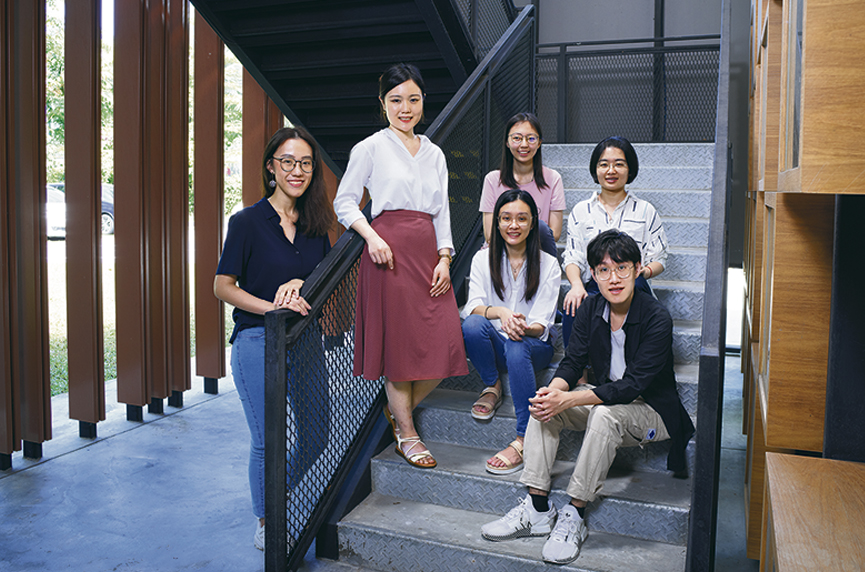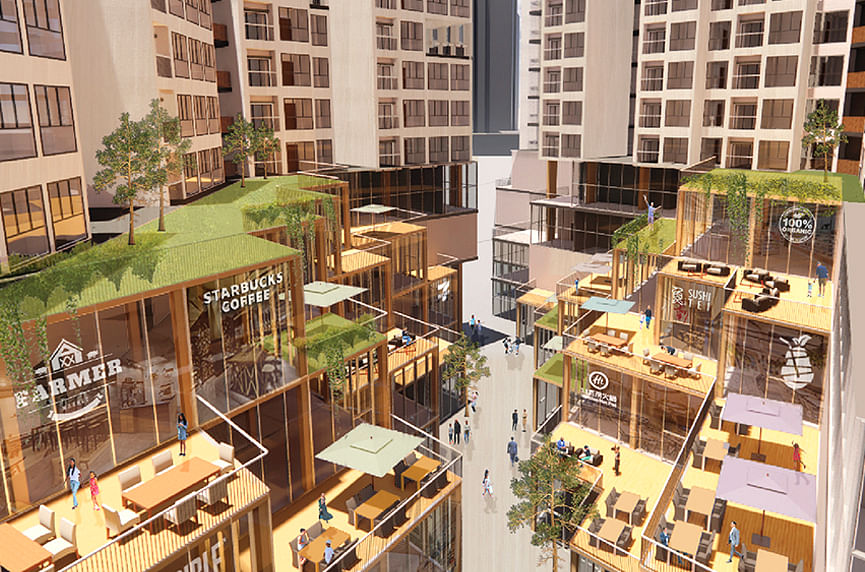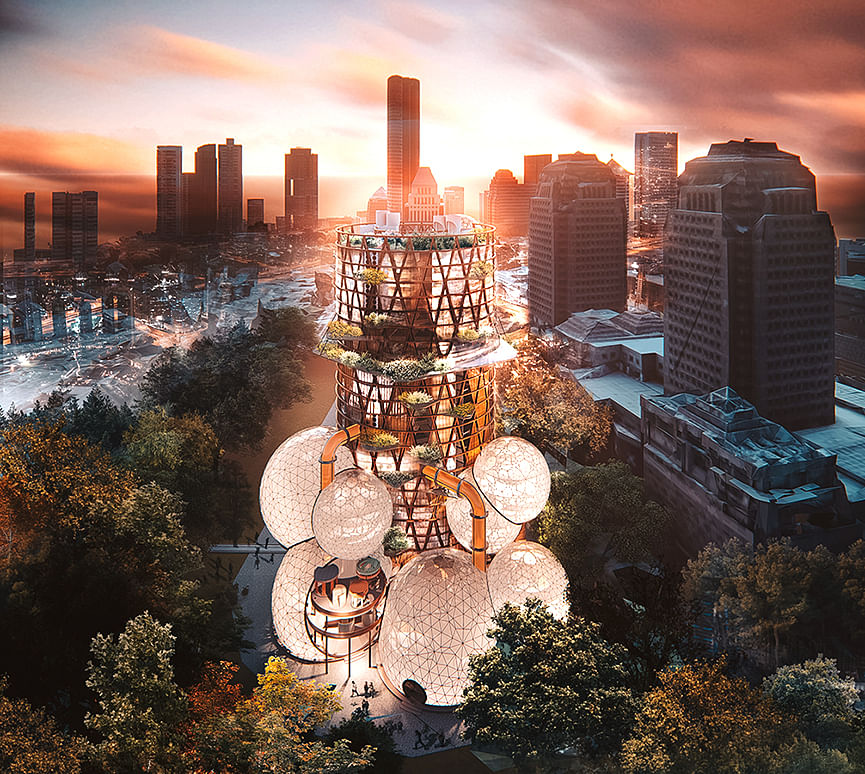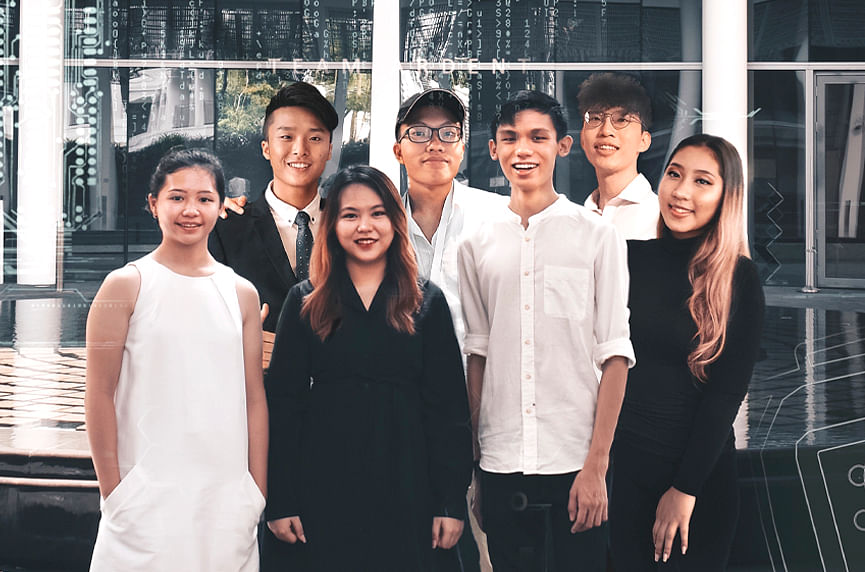BRANDED CONTENT
Singapore students leading the charge to create better, more sustainable buildings with digitalisation
Covid-19 has sped up the digital transformation in the Built Environment sector, and these tertiary students show how digital tools can make processes faster, safer and more cost-efficient

As the International Building Design Competition 2020 was held amidst the pandemic, members of Team Ace, from the National University of Singapore, tapped fully on digital and virtual tools to discuss ideas and work out problems for their winning design.
PHOTO: KOH MENG KWANG
Feng Zengkun
Follow topic:
<div style='position: relative;width: auto;padding: 0 0 7.18%;height: 0;top: 0;left: 0;bottom: 0;right: 0;margin: 0;border: 0 none' id="experience-5fbcaa1bd200f" data-aspectRatio="13.92857143" data-mobile-aspectRatio="9.41176471"><iframe allowfullscreen src='//view.ceros.com/spg/dbs-liner-strip-1-1-1-1-1' style='position: absolute;top: 0;left: 0;bottom: 0;right: 0;margin: 0;padding: 0;border: 0 none;height: 1px;width: 1px;min-height: 100%;min-width: 100%' frameborder='0' class='ceros-experience' title='DBS - Liner Strip 6' scrolling='no'></iframe></div><script type="text/javascript" src="//view.ceros.com/scroll-proxy.min.js" data-ceros-origin-domains="view.ceros.com"></script>
Coming up with a design for a building that's not only memorable but also architecturally sound is challenging at the best of times. Last year, tertiary students who took part in a competition to design such a building in the heart of Orchard Road had an unprecedented obstacle - they had to do so amidst a pandemic.
"We couldn't meet one another face to face to discuss our ideas or work out problems. We did everything digitally, from having online meetings to using virtual tools to record our ideas, and making sure that everyone was on the same page," shares Architecture graduate Ms Grace Ong, 24, who led the eight-strong Team Ace, from the National University of Singapore (NUS), one of three winners for the International Building Design Competition (IBDC) 2020.

IBDC is organised annually by the Building and Construction Authority (BCA) in partnership with NUS, Nanyang Technological University, Singapore Polytechnic (SP), and the Singapore University of Technology and Design, and last year's edition had "Sustainable and Intelligent City" as its theme to underline the benefits of eco-friendly and smart buildings.
Ms Ong and the other teams' experience highlighted the urgent need for Singapore's Built Environment (BE) sector to embrace digital tools to adjust to the Covid-19 world, strengthen its resilience, and transform the sector as it charts a new path forward.
The digital way to better buildings
Tasked with creating an imaginative mixed-use development on a site behind Ngee Ann City, the participating teams tapped on digital tools to analyse the site, develop and optimise their designs, and even simulate construction to find a balance between time and cost.
Using Google Maps, public data such as weather records, and modelling software, each team produced a three-dimensional, digital model of the site and its surroundings, complemented with the ability to test how the site's conditions will affect their proposed building.
With these digital tools, the teams could tweak the best-performing versions to maximise wind flow and ventilation, or better expose or shade different areas, and finally, choose and deliver an optimal design that is both occupant- and environment-friendly.

NUS Architecture student April Zhu, 25, from Team Ace, says: "After we had a preliminary design of our building, we used a tool called Grasshopper to generate many variations that meet the gross floor area we needed to fulfil, the number and types of units we must have, and what we wanted in terms of ventilation and views for residents and visitors."
SP Architecture student Foo Jing Xi, 22, leader of Team Ardent, another winning team in the competition comprising seven students from SP, NUS and Nanyang Polytechnic, explains: "We put the iterations into the digital landscape we created to see if they fit, and modelled how surrounding buildings would cast shadows on them, and how much wind and sunlight each part of the buildings would receive on different days."

Digitalisation also enabled stress-testing to find out if any part of the design was not feasible. For example, Team Ace's original design had large voids in the building for various recreational facilities, but modelling showed that these would require enormous and impractical columns to support the weight of the building above them. As such, the team opted for smaller voids instead.
By integrating all the different components of the building design, from architecture to mechanical and electrical (M&E) services, on a single Building Information Modelling (BIM) system, each team also flagged clashes that needed resolving, such as ensuring sufficient space for pipes and wiring hidden in false ceilings, while maintaining adequate headroom.
Team Ace's Civil Engineering student Xing Da, 22, says: "Many of these things, such as analysing whether columns and beams can support loads, can be done through hand calculations, but these would be extremely time-consuming even for small-scale projects, let alone the designs we were working on."
He adds: "Digital tools not only save time and effort but also help to automate many processes. When we update one part of the building, all of the drawings containing information related to that part are automatically changed. This compresses the workflow and ensures that every team member is working on the latest version of the design."
Even at the construction phase, digital tools will enable builders to calculate the trade-offs involved at different stages, based on available equipment and manpower, so that better, and more informed, decisions can be made.
"Digital tools are essential to meet increasingly complex projects, solve problems, and explore new opportunities in the BE sector, especially with Covid-19," says Ms Abbrielle Loh Jia Min, 21, member of Team Ardent and student of SP Architecture.

Driving digitalisation
As Singapore forges ahead in the wake of the Covid-19 pandemic, digitalisation will be key to helping firms in the BE sector restart their businesses safely, and seize new opportunities ahead.
Mr Owen Wee, 47, principal architect, Surbana Jurong, one of the IBDC 2020 competition's judges, added that digitalisation is crucial for Singapore's sustainability ambitions.
"The digital designs of the buildings are very useful even after the buildings are constructed, such as for maintenance and retrofitting purposes. With Singapore's push for greener buildings, it's very common for property owners to carry out retrofitting projects. We've had cases where we don't have complete information about the building, which results in downstream problems," he says.

Not only are digital tools useful for the industry players, government agencies can also use the digital records to track buildings' carbon emissions across their entire life cycle, from construction to demolition. "The virtual models can tell us the types and quantities of materials that were used to construct the buildings, so that we can determine the embodied emissions," Mr Wee explains.
Even before the Covid-19 outbreak, the Future Economy Council Built Environment Cluster had sought to transform the sector, especially in the critical areas of design for manufacturing and assembly, integrated digital delivery and green buildings.
Its digitalisation efforts included developing industry digital plans to uplift small and medium enterprises, building digital infrastructure, standards and capabilities, and fostering digital innovation to enhance service delivery and growth.
Setting industry standards
While the pandemic has hurt the BE sector and exposed the vulnerabilities of its current work processes and reliance on manual labour, it has also created an opportunity to accelerate the sector's digital transformation, with more firms and organisations now open to investing in digitalisation.
To seize the moment, the Emerging Stronger Taskforce convened an Alliance for Action on Digitalising BE to establish an industry-wide Common Data Environment Data Standards, to support the integration of complex work processes across the value chain, through interoperable digital platforms. Complementing the effort are also initiatives to secure commitment from "power users", such as CapitaLand Limited and City Developments Limited. This is to promote the use of pre-qualified digital platforms that are in line with the Data Standards, and uplift the digital literacy rate of value chain partners (see below, Emerging Stronger Together).
Mr Wee explains that common standards and interoperable software would enable more efficient collaborations. "Right now, you may have architects using one programme because it gives quick renderings that they can show to their clients, and firms responsible for M&E services using another programme, because they don't need this functionality, that may result in non-compatibility.
"Some teams may get together to discuss their software and make sure their drawings and models can be integrated. Others may not. Singapore needs to push much harder for common standards and platforms so that digitalisation can fulfil its full potential."
He adds that such standardisation should extend to details such as file naming conventions and how grid lines are drawn, with an exemplar being the International Organisation for Standardisation (ISO) 19650 standard for managing information over the whole life cycle of a built asset using BIM.
With the majority of design firms, engineers and architects in Singapore working regionally or globally, government agencies should collaborate with others on international standards, not just local ones, he continues.

"Training is the last piece of the puzzle. Students are already studying digital tools as part of their curriculum, but we need targeted training for people in their 30s and older, who are not familiar with the tools. Adopting digitalisation fundamentally changes the way you think and work," he says.
He adds: "Singapore is one of the leaders in adopting digitalisation, in large part due to the Government's efforts, but this lead is very easy to surpass. We need to continue to ramp up our efforts so that digitalisation becomes mainstream in the BE sector, and becomes a way of life for everyone."
Emerging Stronger Together
To help individuals and businesses challenged by Covid-19, the Emerging Stronger Taskforce (EST) harnesses collective resources to help Singaporeans seize new opportunities in the midst of the pandemic.
One of the Taskforce's initiatives is the Alliances for Action (AfAs), which are industry-led coalitions, working in partnership with the Government, to act quickly by prototyping ideas in areas of opportunity for Singapore.
Building on the Future Economy Council Built Environment (BE) Cluster's efforts, the Taskforce convened an AfA on Digitalising Built Environment to catalyse digital transformation of the sector, and strengthen its resilience to external threats and shocks.
Working in close collaboration with the Building and Construction Authority, Infocomm Media Development Authority, and JTC Corporation, the AfA has launched an industry-wide Common Data Environment Data Standards, and the Coalition for Built Environment Digitalisation (CfBED), an industry digital partnership to drive digital adoption and enhance digital literacy.
To date, the AfA has secured the commitment of more than 300 industry stakeholders and 25 projects onboard the CfBED. Leveraging the complementary expertise of public and private sector stakeholders, the AfA aspires to an integrated and collaborative BE future that is digitally enabled, resilient, sustainable and productive.
For more, visit emergingstronger.sg
This is the last in a six-part series on the resilience of Singaporeans, as they band together to seize new opportunities in a world changed by Covid-19.
In partnership with the Emerging Stronger Taskforce.
In partnership with the Emerging Stronger Taskforce.

